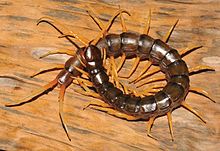Scolopendra cataracta
| Scolopendra cataracta | |
|---|---|
 |
|
| Scientific classification | |
| Kingdom: | Animalia |
| Phylum: | Arthropoda |
| Subphylum: | Myriapoda |
| Class: | Chilopoda |
| Order: | Scolopendromorpha |
| Family: | Scolopendridae |
| Genus: | Scolopendra |
| Species: | S. cataracta |
| Binomial name | |
|
Scolopendra cataracta Siriwut, Edgecombe & Panha, 2016 |
|
Scolopendra cataracta (waterfall centipede) is a species of centipede in the family Scolopendridae . It is the first known amphibious centipede, growing to up to 20 centimetres (7.9 in) in length.
George Beccaloni, an entomologist and curator at the Natural History Museum, London, found a specimen of S. cataracta near the Khao Sok National Park in 2000, while on honeymoon in Thailand. Beccaloni described the centipede as "pretty horrific-looking: very big with long legs and a horrible dark, greenish-black colour" but what caught his attention was that it scurried into a stream rather than the forest when he turned over the stone it was hiding under on the stream bank – unusual behaviour as centipedes typically avoid water. It then ran along the stream bed and hid under a rock underwater. After capturing the centipede, Beccaloni observed that it swam like an eel below the water's surface; his discovery was greeted with scepticism by an expert on Scolopendra, as these centipedes usually occur in dry habitats, and no amphibious species of centipede had been known until then.
Gregory Edgecombe, a colleague of Beccaloni's in London, and his Thai student Warut Siriwut collected two specimens near Laotian waterfalls and DNA analysis confirmed they belonged to a new centipede species which they named S. cataracta, from the Latin for waterfall. There are only four known specimens of this species. In addition to Edgecombe and Siriwut's specimens, Edgecombe confirmed that Beccaloni's specimen from 2000 was S. cataracta, and the Natural History Museum turned out to have a Vietnamese specimen from 1928 which had been misidentified. Beccaloni is the only person to have observed the centipede swimming and has hypothesised that its ecological niche is based on "this species [going] into the water at night to hunt aquatic or amphibious invertebrates." The confirmation of the new species was published in the journal ZooKeys in 2016.
...
Wikipedia
